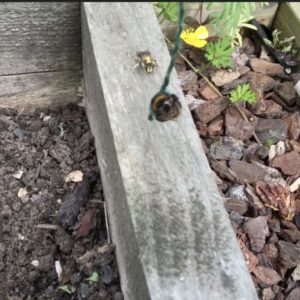Would the male Wool carder bee attack the bumblebee on a string?
After observing the frantic antics of a male wool carder bee and filming them. I saw it chase away butterflies, hoverflies, attack a male B. pratorum, a male solitary bee and closely inspect a wood chip on a string, what would happen if I tied a dead bumblebee to the string… would it attack it as well? Watch the video……
Abdominal mace!
Male Wool carder bees (Anthidium manicatum) attack other flying insects that enter their territory. He holds and defends it as he hopes will entice females into his domain. To back up his territorial claim, males are armed with 5 sharp ‘mace-like spines’, at the end of his abdomen. If another male or other insects arrive or feed in this area, he will grab the intruder, whilst they are still feeding, in a bear- like ‘hug’ and press the mace-like spines into its body. If the intruder was flying, defending males observe the intruder and suddenly rush into and ram it and high speed. Shortly before impacting the intruder, males curve their abdomen forward to strike at the intruder with the 5 spines. The intruder can be injured by such an attack or even killed.
Clearly, the poor male Bombus lapidarius that was attacked left it bewildered and unable to fly.
Wool carder bees will use a Nurturing Nature observation nest box as will several others bees and by planting these flowers in your garden you just may attract your own Samurai warrior bees!
“All my articles and videos, available free, are funded by my presentations and sales of award-winning bumblebee nest boxes, solitary bee boxes, and wormeries. Please help by spreading the word and forwarding this link to your friends and colleagues. https://nurturing-nature.co.uk Thank you” George Pilkington
Excellent overview of Wool carders here
Download a BWARS Information Sheet about Wool carder bees
For info and link to buy an excellent book Field Guide to the Bees of Great Britain and Ireland by Steven Falk
An extremely useful resource supports this book by a special website feature within Steve Falk’s Flickr website which furnishes extra photos and other useful resources to assist with identification.
Solitary Bees book by Ted Benton
Interested in Citizen Science and pollinators? The Buzz Club



Am finding alot of bumblebee with damage wings is it possible it’s the carder bee doing this ?